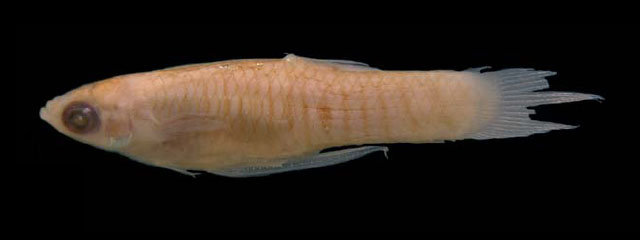| Poeciliidae (Poeciliids), subfamily: Poeciliinae |
| 1.99 cm SL (male/unsexed); 3.29 cm SL (female) |
|
benthopelagic; freshwater |
| South America: Rio Jacareí drainage and neighbouring, which flows into the Baía de Paranaguá in Paraná, Brazil. |
|
Dorsal soft rays (total): 7-8; Anal soft rays: 9-10; Vertebrae: 32-32. Diagnosed from all other species of the genus except Phalloceros megapolos, Phalloceros spiloura, Phalloceros malabarbai, Phalloceros alessandrae, Phalloceros anisophallos, Phalloceros uai, Phalloceros lucenorum, Phalloceros pellos, and Phalloceros reisi by the female urogenital papilla curved
to the right, located laterally (vs. slightly left turned and with a lateral ramus or straight located along midventral line); and border of the anal aperture in contact with the first anal-fin ray or very close to it (vs. separated from first anal-fin ray by the female urogenital papilla). Differs from Phalloceros spiloura by the absence of a caudal peduncle spot (vs. presence
of caudal peduncle spot); from Phalloceros megapolos by the gonopodium appendix normally developed (vs. greatly expanded in wing like projections); from Phalloceros uai by the absence of a wide and square-shaped lateral spot in large specimens (vs. presence of such spot). Distinguished from Phalloceros alessandrae and Phalloceros malabarbai by halves of gonopodial paired appendix sickle like (vs. not sickle like); medial corner absent (vs. present); hook on left half of gonopodial paired appendix and right hook absent (vs. hook on both halves of gonopodial paired appendix); and left hook small, directed downward or up- and forward, and located closer to the base of gonopodial appendix (vs. hooks large downward directed and located in the corner of gonopodial appendix). Differs from Phalloceros anisophallos, Phalloceros lucenorum, Phalloceros pellos, and Phalloceros reisi by the halves of the gonopodium slender and similar to each other (vs. halves of the gonopodium wide and different from each other; right half wider than left one) (Ref. 76852).
Description: Pectoral fin with 7 branched rays; longitudinal series of scales 28-30; transverse series of scales 7 (Ref. 76852). |
|
|
Least Concern (LC); Date assessed: 18 May 2022 Ref. (130435)
|
| harmless |
|
Source and more info: www.fishbase.org. For personal, classroom, and other internal use only. Not for publication.

